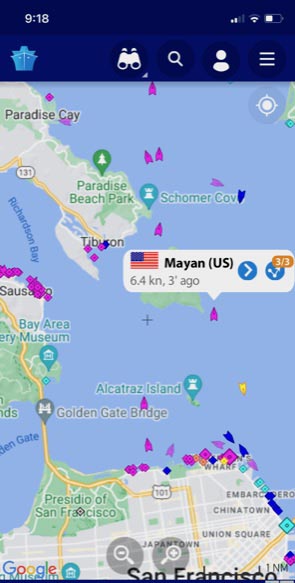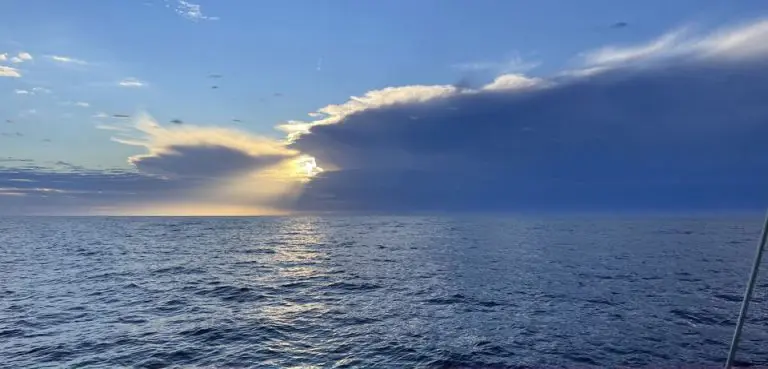
Shady Ships Signal Fake AIS Positions
See a ship on AIS? It might not be there. According to the New York Times there’s an increasing amount of fraud on the AIS system, primarily by illicit commercial shipping and fishing companies trying to avoid detection. The Times reports, “The vessels carry out the deception by adopting a technology that until recently was confined to the world’s most advanced navies. The technology, in essence, replicates the effect of a VPN cellphone app, making a ship appear to be in one place while physically being elsewhere.”
Why are ships doing this? For fishing fleets it’s pretty obvious they don’t want to be seen fishing in protected waters. If you’re a Cypriot oil tanker owner who wants to dodge sanctions on Venezuelan oil and not let your bank or insurance company find out where you are, it’s important that your AIS signal appear somewhere other than at a Venezuelan oil terminal.

We contacted the Coast Guard asking if ships could show up in front of you on your AIS at sea, but not really be there. CWO Kurt Fredrickson of USCG Media Relations replied, “Yes, they could and could be a nuisance, but not a safety risk — vessels can’t collide with phantom targets. Note, AIS is an identification system to assist mariners in identifying targets that otherwise are seen by radar or visually. It — AIS broadcasts or AIS web services — should not be relied upon to make navigational decisions. FYI, contrary to what the NYT article insinuates, this has nothing to do with GPS. An analogy would be blaming your ISP/email service for receiving spam. Deceptive AIS reports are generated either by false AIS broadcasts or by hacking AIS web services (mostly the latter). For those relying on AIS web services, it would be difficult to ascertain what is true and what’s not.”
While it is true that you can’t hit something that’s not really there, it could be more than unsettling. Do you now mistrust your instruments? Or your eyes? AIS targets showing up on your screen through your VHF antenna are more likely to be there since it’s a local signal, but if your AIS data are coming through your Starlink or IridiumGO! internet connection, then you may be seeing things on your screen that aren’t really there. Sleep-deprived singlehanded sailors often report seeing illusions. This could only be compounded by not seeing things their instruments are telling them should be there.

We often head to sea to escape the world’s troubles ashore. However, the technology we bring, which increasingly eases our communication and navigation challenges, comes with the risks we are trying to leave behind. AIS is getting “hacked” by illicit ships and fishing fleets, and all while the separate problem of GPS spoofing is also disrupting the perceived safety we’ve been gaining from all of this technological gadgetry. The increasing disruptions to digital navigation systems arrive at the same time that we’ve heard the major chart agencies are finally committed to phasing out paper charts.
If you are headed south with this year’s Baja Ha-Ha and bringing a sextant, you’ll be happy to know that Paul Kamen will be running a celestial navigation clinic on the beach in Turtle Bay. This will be just ahead of one of Mother Nature’s great hacks when she performs the “now you see, it now you don’t” hack by making the moon disappear during a total eclipse on November 7-8. Humans weren’t the first to fool with trusted navigational aids.
At this stage of the game, it is unlikely that the small number of devious players doing AIS hacking or GPS spoofing are going to affect the average sailor, but it’s a reminder that you should probably stick your head out of the hatch frequently at sea and change your passwords frequently while ashore. Sailing teaches eternal vigilance, and a “belt-and-suspenders” approach to navigation will remain a wise practice for the foreseeable future.

A couple of comments. While navigating, “Seeing” a ship on AIS is not using a mobile device with an app that receives AIS information from a ground station internet relay. That’s not how the AIS system works. AIS works through VHF radio and if you don’t have an AIS receiver, then you’re just playing around with some app – not navigating with AIS. Second, totally disagree with USCG comments because if a ship reports its position incorrectly, then where it actually is has a higher likelihood of collision, not just “nuisance”. Lastly, a little disappointed there was no mention of the electronics industry here because it is their failure. This problem of spoofing is the most grade school problem to be solved with off the shelf security software (much in the same way latitude38 has the lock next to their url – we know they own it)
Phony AIS signals have long been a problem with illegal fishing boats, which unfortunately, now comprise a large proportion of the commercial fishing boats in the oceans. Illegal fishing is a huge environmental problem, and I’d love to see Latitude 38 do a story on this. Sea Shepherd Conservation Society has done excellent work on this issue, and their work would be a good starting point.
I’d be more concerned about a ship that’s in front of me on a moonless night that is reporting its location somewhere else. Since they are trying to hide, I’d not be surprised if they were running dark.